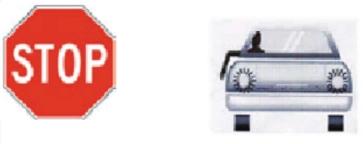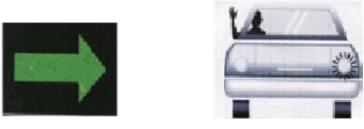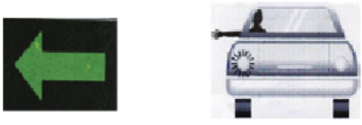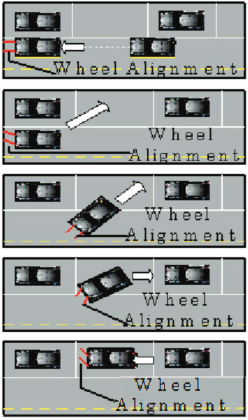
Lithonia Customer Service Center is experiencing an outage.
Please use Online Services as we work to resolve the issue.
Section 5: Turning Signals & Parallel Parking
Turn Signals and Making Turns Safely
Turn movements by motor vehicles are regulated by law, and failure to observe or comply is a violation. Drivers must know and understand the law in order to turn safely and avoid crashes.



A turn signal must be given whenever a turn is made to the right or the left. You must give a continuous turn signal for an adequate distance to alert other drivers before turning. Never decide to make a turn at the "last minute." Turning quickly or erratically can be dangerous to you and other drivers.
Illegal Signals
It is against the law to flash turn signals as a courtesy or "do pass" signal to other drivers in the rear.
How To Make A Right Turn
- Using appropriate signals, and giving drivers ahead of and behind you adequate notice, activate your right turn signal;
- Approach the intersection in the right lane, staying as close as practicable to the curb or edge of the roadway;
- If there is a bicycle lane on the road on which you are traveling, you must yield to bicyclists traveling straight through the intersection before making a right turn;
- Make the turn in such a way as to end up in the right lane of the street into which you have turned and avoid entering any other lane of traffic. If there are multiple turning lanes on the street you are turning from, complete the turn so that your vehicle ends up in the corresponding lane on the street you are turning onto.
How To Make A Left Turn
- Using appropriate signals, and giving drivers ahead of and behind you adequate notice, activate your left turn signal;
- Move into the far left lane of the direction in which you are traveling, or into the turning lane if one is provided;
- Keep your wheels straight until you begin making the turn;
- Yield the right-of-way to all vehicles, including bicycles, which are approaching from the opposite direction, and pedestrians crossing either roadway;
- When safe to do so, and when traffic signals/signs permit, make your turn so that your vehicle ends up in the lane closest to the center lane(s) in your direction of traffic on the street you turned onto, or closest to the center line if there is no center lane;
- If there are multiple turning lanes on the street you are turning from, complete the turn so that your vehicle ends up in the corresponding lane on the street you are turning onto;
- Once you have entered an intersection to make a left turn, you cannot change lanes in the intersection;
- You must stop and remain stopped for any pedestrians in the crosswalk of the road you are turning onto until they have cleared the lanes of traffic that you are traveling on.
Watching for Pedestrians When Making Turns

At most intersections where there is a pedestrian signal, the "Walk" signal of the crossing street corresponds to the green light of the roadway you are traveling on. This means that when you are authorized to turn, pedestrians are authorized to cross the street onto which you are turning at the same time. Therefore, before making your turn, you must stop and remain stopped for any pedestrians in the crosswalk of the road onto which you wish to turn until they have cleared the lanes of traffic upon which you are traveling.
U-Turns
Do not make a U-turn on a curve or near the top of a hill if you cannot be seen by other drivers approaching from either direction. Do not make a U-turn where signs prohibit doing so.
Making Turns on Multi-Lane Highways
On a multi-lane, two-way highway, you must never drive to the left of the center line except when making a left turn. If traffic control signals or signs are present, you may only complete the turn when authorized to do so by the traffic control signals or signs. When making left turns, you must always yield to oncoming traffic, and wait for pedestrians to clear the lanes of traffic, driveway, sidewalk, or alley you are turning into.
Stopping, Standing, and Parking
It is against the law to park on a highway. If the vehicle is disabled, you should make every practical effort to park off the highway, leaving free passage and a clear view of your vehicle for 200 feet in each direction.
Stopping, Standing or Parking is not permitted under the following conditions at any time:
- On the street side of any parked vehicle;
- On a sidewalk;
- Within an intersection;
- On a crosswalk;
- Between a safety zone and the adjacent curb;
- Alongside or opposite any street excavation or obstruction when stopping, standing, or parking would obstruct traffic;
- Upon a bridge or overpass, or within a highway tunnel;
- On any railroad tracks;
- On a controlled access roadway;
- In the area between roadways on a divided highway, including crossovers;
- At any place marked by a no-parking sign.
Stopping, Standing or Parking is permitted only momentarily to pick up or drop off passengers under the following conditions:
- In front of a public or private driveway;
- Within 15 feet of a fire hydrant;
- Within 20 feet of a crosswalk at an intersection;
- Within 30 feet of a stop sign, yield sign, or traffic control signal;
- Within 20 feet of a fire station driveway;
- Within 75 feet of the spot across the street from a fire station driveway;
- Within 50 feet of a railroad crossing;
- At any place where official signs prohibit standing.
Steps to Parallel Parking
When attempting to parallel park, drive past the parking space you wish to use and stop when you are approximately even with the car ahead of the space (you should be approximately 2 feet from the other car – door to door).

- Turn your wheels sharply to the right and back slowly toward the car behind the space you wish to use;
- As your front door passes the back bumper of the car ahead of the space you wish to use, quickly straighten your wheels and continue to back diagonally into the space in a straight line;
- When your front bumper is completely clear of the car ahead of you, turn your wheels sharply to the left and back slowly toward the car behind you;
- Stop before making contact with the car behind you. Place the car in drive, turn your wheels sharply to the right and pull toward the center of the parking space;
- Always give the appropriate turn signal prior to beginning your parking maneuver and when you exit from a parallel parking space.